
The Virgin of the Rocks, sometimes the Madonna of the Rocks, is the name of two paintings by the Italian Renaissance artist Leonardo da Vinci, of the same subject, with a composition which is identical except for several significant details. The version generally considered the prime version, the earlier of the two, is unrestored and hangs in the Louvre in Paris. The other, which was restored between 2008 and 2010, hangs in the National Gallery, London. The works are often known as the Louvre Virgin of the Rocks and London Virgin of the Rocks respectively. The paintings are both nearly 2 metres high and are painted in oils. Both were originally painted on wooden panels, but the Louvre version has been transferred to canvas.
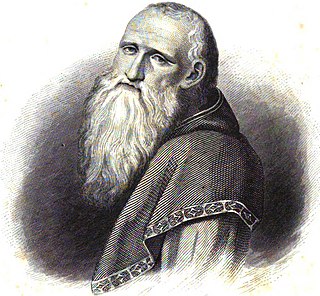
Bernardino Luini was a north Italian painter from Leonardo's circle during the High Renaissance. Both Luini and Giovanni Antonio Boltraffio were said to have worked with Leonardo directly; he was described as having taken "as much from Leonardo as his native roots enabled him to comprehend". Consequently, many of his works were attributed to Leonardo. He was known especially for his graceful female figures with elongated eyes, called Luinesque by Vladimir Nabokov.
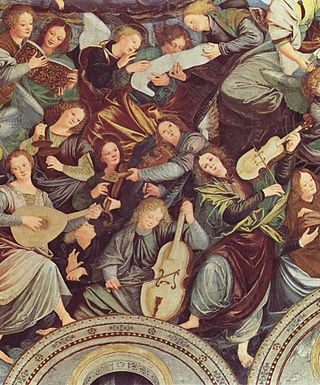
Gaudenzio Ferrari was an Italian painter and sculptor of the Renaissance.
Andrea Solari (1460–1524) was an Italian Renaissance painter of the Milanese school. He was initially named Andre del Gobbo, but more confusingly as Andrea del Bartolo a name shared with two other Italian painters, the 14th-century Siennese Andrea di Bartolo, and the 15th-century Florentine Andrea di Bartolo.

Bartolomeo Suardi, best known as Bramantino, was an Italian painter and architect, mainly active in his native Milan.

The Virgin and Child with Saint Anne and Saint John the Baptist, sometimes called The Burlington House Cartoon, is a drawing by Leonardo da Vinci. The drawing is in charcoal and black and white chalk, on eight sheets of paper that are glued together. Because of its large size and format the drawing is presumed to be a cartoon for a painting. No painting by Leonardo exists that is based directly on this cartoon, although the drawing may have been in preparation for a now lost or unexecuted painting commissioned by Louis XII. The drawing is the only extant larger-scale drawing by the artist.
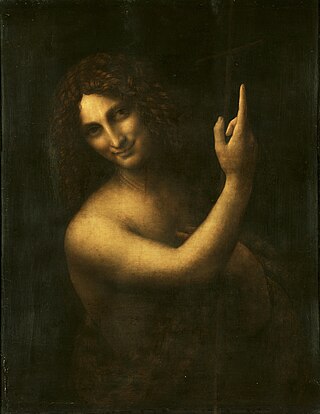
Saint John the Baptist is a High Renaissance oil painting on walnut wood by Leonardo da Vinci. Likely to have been completed between 1513 and 1516, it is believed to be his final painting. Its original size was 69 by 57 centimetres.
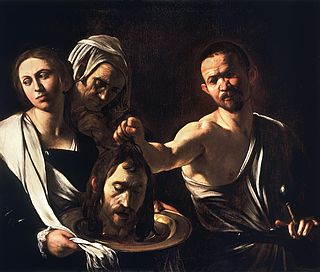
Salome with the Head of John the Baptist (London), c. 1607/1610, is a painting by the Italian master Caravaggio now in the collection of the National Gallery in London.

Giovanni Antonio Boltraffio was an Italian painter of the High Renaissance from Lombardy, who worked in the studio of Leonardo da Vinci. Boltraffio and Bernardino Luini are the strongest artistic personalities to emerge from Leonardo's studio. According to Giorgio Vasari, he was of an aristocratic family and was born in Milan.

Cesare da Sesto (1477–1523) was an Italian painter of the Renaissance active in Milan and elsewhere in Italy.
The decade of the 1480s in art involved some significant events.
The decade of the 1460s in art involved some significant events.
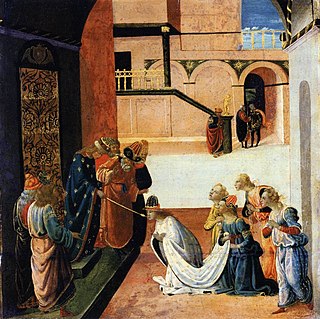
Jacopo del Sellaio (1441/42–1493), was an Italian painter of the early Renaissance, active in his native Florence. His real name was Jacopo di Arcangelo. He worked in an eclectic style based on those of Botticelli, Filippino Lippi, and Domenico Ghirlandaio. The nickname Sellaio derives from the profession of his father, a saddle maker.

Giampietrino, probably Giovanni Pietro Rizzoli, was a north Italian painter of the Lombard school and Leonardo's circle, succinctly characterized by S. J. Freedberg as an "exploiter of Leonardo's repertory."

Bernardino de 'Conti was an Italian Renaissance painter, born in 1465 in Castelseprio and died around 1525.

The Pinacoteca del Castello Sforzesco is an art gallery in the museum complex of the Castello Sforzesco in Milan, northern Italy.

The Leonardeschi were the large group of artists who worked in the studio of, or under the influence of, Leonardo da Vinci. They were artists of Italian Renaissance painting, although his influence extended to many countries within Europe.

Holy Family with Saints Anne and John the Baptist is a c. 1530 oil on panel painting by Bernardino Luini. It was previously in the collection of cardinal Federico Borromeo, who recorded his acquisition of it in his writings and gave it to the new Biblioteca Ambrosiana in Milan in 1618, where it still hangs. The work was seized in 1796 by occupying French troops and taken to Paris, where it hung in the Louvre until being returned to Milan in 1815.
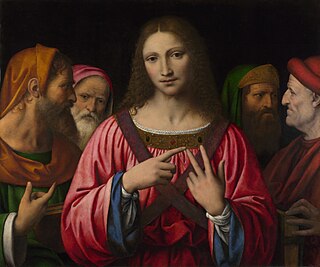
Christ Among the Doctors is an oil painting on panel of c. 1510–1530 by the Italian Renaissance artist Bernardino Luini in the National Gallery, London, depicting Christ with the doctors of the law. In addition to the prime version in London, copies of varying quality also survive.

















